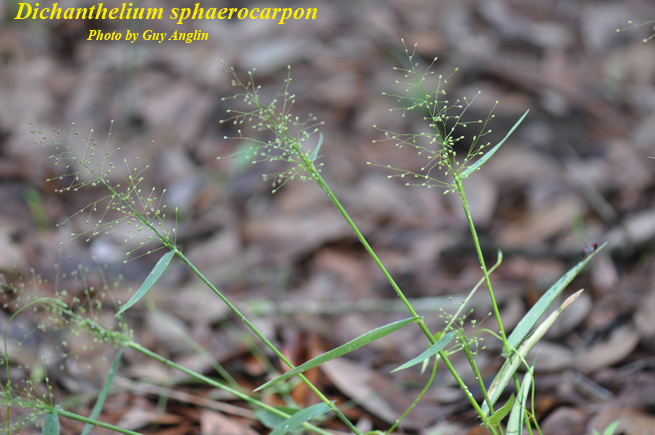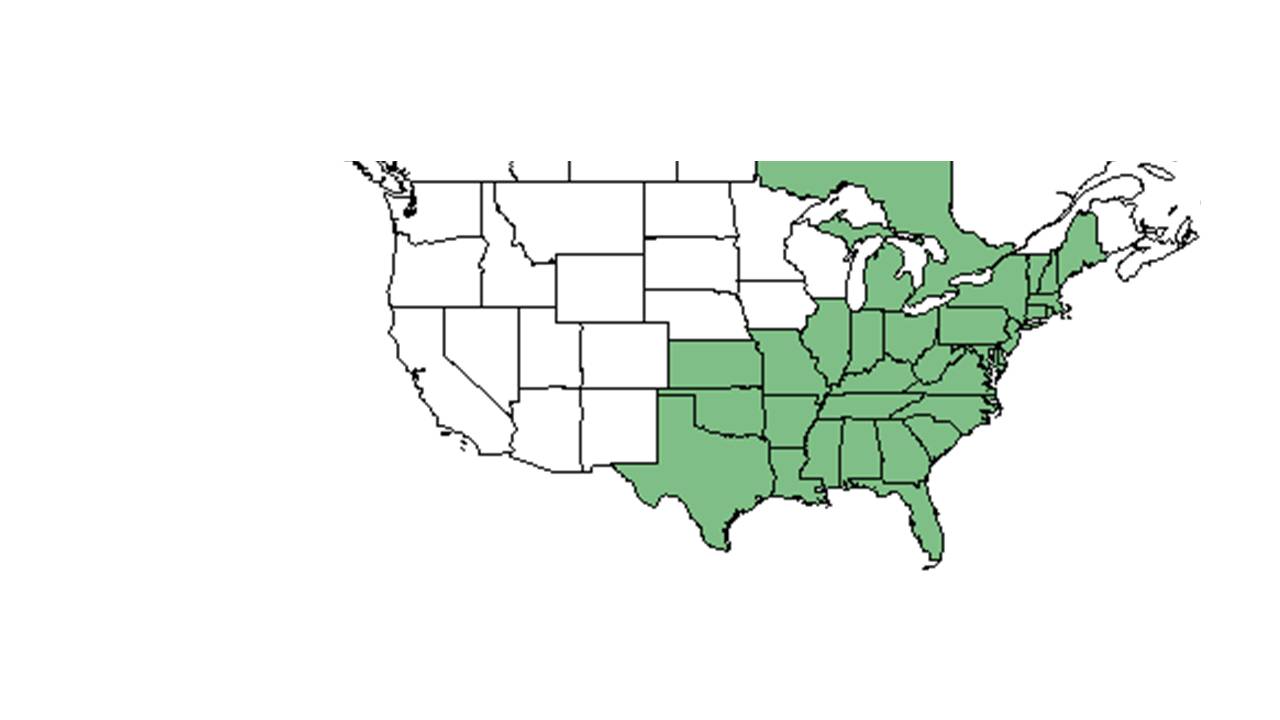Difference between revisions of "Dichanthelium sphaerocarpon"
Laurenloria (talk | contribs) (→Seed dispersal) |
Rwagner914 (talk | contribs) |
||
| Line 8: | Line 8: | ||
| divisio = Magnoliophyta - Flowering plants | | divisio = Magnoliophyta - Flowering plants | ||
| classis = Liliopsida – Monocotyledons | | classis = Liliopsida – Monocotyledons | ||
| − | | ordo = | + | | ordo = Poales |
| familia = Poaceae ⁄ Gramineae | | familia = Poaceae ⁄ Gramineae | ||
| genus = ''Dichanthelium'' | | genus = ''Dichanthelium'' | ||
Revision as of 18:48, 29 June 2017
| Dichanthelium sphaerocarpon | |
|---|---|

| |
| Photo by Guy Anglin, Atlas of Florida Vascular Plants | |
| Scientific classification | |
| Kingdom: | Plantae |
| Division: | Magnoliophyta - Flowering plants |
| Class: | Liliopsida – Monocotyledons |
| Order: | Poales |
| Family: | Poaceae ⁄ Gramineae |
| Genus: | Dichanthelium |
| Species: | D. sphaerocarpon |
| Binomial name | |
| Dichanthelium sphaerocarpon (Elliott) Gould | |

| |
| Natural range of Dichanthelium sphaerocarpon from USDA NRCS Plants Database. | |
Common names: Roundseed panicgrass; Roundseed witchgrass
Contents
Taxonomic notes
Synonyms: Panicum sphaerocarpon Elliott; P. sphaerocarpon var. inflatum (Scribner & J.G. Smith) A.S. Hitchcock & Chase; P. sphaerocarpon var. sphaerocarpon
Description
Dichanthelium sphaerocarpon is a perennial graminoid.
Generally, for the Dichanthelium genus, they have "spikelets usually in panicles, round or nearly so in cross section, 2-flowered, terminal fertile, basal sterile, neutral or staminate. First glume usually present, 2nd glume and sterile lemma similar; fertile lemma and palea indurate without hyaline margins. Taxonomically our most difficult and least understood genus of grasses, more than 100 species an varieties are ascribed to the Carolinas by some authors. Note general descriptions for species groups (e.g., 1-4, 5-8, 9-13, and 26-62)." [1]
Specifically, for the D. sphaerocarpon species, they are "perennial with distinct basal rosettes; branching, when present, from nodes above basal rosette. Leaves basal and cauline, vernal and autumnal. Culms 1,5-5 dm tall, nodes upwardly bearded, internodes glabrous. Blades to 9.5 cm long, 2-20 mm wide, glabrous or slightly scaberulous on both surfaces, margins white, scaberulous, bases cordate, ciliate; sheaths glabrous, margins papillose-ciliate; ligules obsolete or ciliate and 0.1-0.5 mm long. Panicle 4-13 cm long, 2-9 cm broad, 2/3 or more as borad as long; rachis glabrous, branches spreading-ascending, glabrous. Spikelets subglobose, 1.4-1.6 mm long; pedicels glabrous. First glume glabrous, truncate, acute, or obtuse, 0.3-0.8 mm long, 2nd glume and sterile lemma puberulent, obtuse, 1.4-1.6 mm long; fertile lemma and palea 1.3-1.5 mm long. Grain 1 mm long. yellowish or purplish, broadly ellipsoid or subglobose." [1]
Distribution
Ecology
Habitat
Dichanthelium sphaerocarpon occurs in a variety of natural and disturbed communities. It is abundant in barrens habitats[2], but also occurs in pine-oak flatwoods and woodlands, mixed hardwood floodplains, pine forests, cabbage palm hammocks, and on loessial banks, the edges of open brackish marshes, and sand dunes. [3] It is also able to grow in disturbed areas, especially in higher light levels. [3] D. sphaerocarpon has been found in power line corridors, clear-cuts, roadsides, ditches, firebreaks, and old fields. [3] This species seems to prefer sandy or loamy soils, but can tolerate a range of moisture levels, from dry to wet. [3] Associated species include Carex, Juncus, Sarracenia, Taxodium. [3]
Phenology
Flowering and fruiting has been observed in Florida in February through November. [3]
Seed dispersal
This species disperses by gravity. [4]
Fire ecology
It increased from being absent to 19 plots within the span of six years after an early dormant-season fire in 1989 at Gibbons Creek Barrens.[2]
Conservation and management
Cultivation and restoration
Photo Gallery
References and notes
- ↑ 1.0 1.1 Radford, Albert E., Harry E. Ahles, and C. Ritchie Bell. Manual of the Vascular Flora of the Carolinas. 1964, 1968. The University of North Carolina Press. 142-158. Print.
- ↑ 2.0 2.1 Taft, J. B. (2003). "Fire effects on community structure, composition, and diversity in a dry sandstone barrens." Journal of the Torrey Botanical Society 130: 170-192.
- ↑ 3.0 3.1 3.2 3.3 3.4 3.5 Florida State University Robert K. Godfrey Herbarium database. URL: http://herbarium.bio.fsu.edu. Last accessed: June 2014. Collectors: Loran C. Anderson, T. MacClendon, K. MacClendon, Cecil R Slaughter, Lisa Keppner, Ed Keppner, R. Kral, Richard Carter, Charles M. Allen, Sidney McDaniel, Randy Haynes, Paul L. Hallister, Ken Rogers, Louise Rogers, Lloyd H. Shinners, Duane Isely, S L Welsh, Dwight Isely, Bayard Long, John W. Thieret, D J Banks, Fred B Jones, A. E. Radford, R. L. Wilbur, James D. Ray, Jr., Robert F. Thorne, Bob Brown, W. T. Batson Jr., H. L. Blomquist, R.K. Godfrey, P. L. Redfearn, H. Kurz, Bruce Hansen, JoAnn Hansen, Gil Nelson, Angus Gholson, Chris Cooksey, Kevin Oakes, Richard R. Clinebell II, J. M. Kane, C. Nelson, A. Clebsch, Annie Schmidt, A. Johnson, and M. Jenkins. States and Counties: Alabama: Geneva, Houston, Lee, and Monroe. Arkansas: Franklin and St. Francis. Florida: Bay, Calhoun, Collier, Escambia, Flagler, Franklin, Gulf, Holmes, Jackson, Leon, Liberty, Taylor, Wakulla, and Washington. Georgia: Baker, Dougherty, Grady, and Thomas. Kentucky: Lyon. Louisiana: Allen, Caldwell, Jackson, Ouachita, St Mary, and Union. Mississippi: Holmes, Jones, Lowndes, and Pearl River. North Carolina: Beaufort, Brunswick, Craven, and Granville. New Jersey: Gloucester. Tennessee: Putnam. Texas: Freestone, Nueces, San Augustine, and Van Zandt. Virginia: Princess Anne and Prince George. Other Countries: Honduras.>
- ↑ Kirkman, L. Katherine. Unpublished database of seed dispersal mode of plants found in Coastal Plain longleaf pine-grasslands of the Jones Ecological Research Center, Georgia.